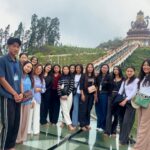



About the Course
| History is a study of the past through the written records and archaeological findings from the pre-historic ancient past to the modern age. |
Course Outcome
C1 His/Mj-101: History of India (from earliest time to Gupta period)
1. Students will learn the historio-graphical trends of ancient Indian history up to 300 C.E.
2. They will learn to interpret the historical sources of ancient India.
3. They will learn about the prehistoric period in India (which will include the palaeolithic, Mesolithic, Neolithic and Chalcolithic cultures)
4. They will learn about the proto-historic period in India (viz. the Harapan civilization)
5. They will learn about the historic period of India up to the Gupta period
C-2 – His/Mj-102: Social formations and cultural patterns of the ancient world
1. The students will acquire knowledge about the significant developments in world history that have shaped the complexity and history of human existence.
2. The students will understand that the pace and nature of change differed in different parts of the world.
C-3 – His/Mj-201:Historyof India (post Gupta to 1200 C.E.)
1. The course will help the students understand the process of transition from ancient to early medieval period.
2. The students will understand the growing political, social and economy during early medieval period.
3. The students will understand and appreciate the religious and cultural developments during this period.
C-4 – HIS/MJ-202: Social formations and cultural patterns of the medieval world
1. The students will get familiarized with different dimensions of the rise of the early modern west.
2. They will learn how the economic, social and religious development was made during the medieval European society.
3. They will be able to critically analyse the crises of the Roman empire.
4. They will learn about the socio-economic and political condition of the feudal organization/mode of production, towns formation, trade and commerce, technological developments and religion in Medieval Europe.
C-5 – HIS/MJ-301: History of India (C.1206-1526)
1. Students will learn about the major political developments in the history of India from 1206-1526
2. They will acquire knowledge about the economic, social and religious (bhakti and sufi movements) developments made during this period)
3. They will learn about the development of trade and urban complexes during this period.
C-6 – HIS/MJ-302: History of Europe 13th century to 1789
1. The students will develop an understanding of renaissance and its aftermath on European society
2. They will be able to learn and understand the rise and impact of reformation movement globally.
3. The students will understand the transition from feudalism to capitalism and the emergence of Nation states.
4. The students will acquire knowledge and understanding about the important revolutions of the world Viz. the scientific revolutions, the glorious revolution, the industrial revolution and the French revelation.
C-7 – HIS/MJ-401: History of India (C.1526-1605)
1. The students will learn about the various sources of Indian history and understand the developments that took place in India during C.1526-1605.
2. Students will be able to learn about the establishment, consolidation and expansion of the Mughal empire.
3. They will acquire knowledge about the society and economy of the people during the Mughal rule in India.
C-8 – HIS/MJ-402: History of Europe: 1789-1919
1. The students will be able to analyse the historical development in Europe between 1789-1919. This includes the rise and fall of Napoleon & the unification of Germany and Italy as a nation
2. The students will understand the democratic and socialist foundations of modern Europe (Capitalist industrialization and rise of new social classes)
3. The students will be able to situate historical development of socialist upsurge and other ideological shifts.
4. They will learn about the circumstances leading to the first world war and the establishment of New World order in its aftermath.
C-9 – HIS/MJ-501: History of Modern world: 1919-1945
1. The students will understand the shifting history from Eurocentrism to a New world order.
2. They will be able to understand the circumstances leading to the second world war, which encompasses the turbulent times when totalitarianism rose as an alternative to democratic and liberal ideals.
3. The students will be able to comprehend the growing desire for peace in the aftermath of the war, through the formation of organizations such as the United Nations.
C-10 – HIS/MJ-502: History of India (C.1605-1707)
1. The students will learn and understand about the political development in the history of India between 1605-1707.
2. By discussion the nature of the social, political and religious foundations of Mughal. India as a dynamic process, the student will acquire multifaceted understanding of the factors that shaped state and society in the Mughal period that carried into the later colonial state.
C-11 – HIS/MJ-503: Historiography
1. The course will enable the students to understand the basic concepts that go to make up the subject matter of history.
2. Students will learn and understand the meaning of history, its nature and scope.
3. They will be able to establish the relationship between history and the other social sciences
4. Fundamental concepts of history including the ideologies forwarded by leading historians of the world will be discussed.
5. The students will study about the prevailing trends in modern Indian historiography.
C-12 – HIS/MJ-601: History of India (1707-1857)
1. The students will understand the condition of Indian states in the 18th Century
2. They will gain knowledge on how the East India company captured political and economic power from Indian regional rulers.
3. The students will be able to trace the first awakenings of anti-colonial and nationalist feelings among the Indian, which ultimately led to the overthrow of colonial rule in India
C 13 – HIS/MJ-602: Political history of the Nagas
1. The paper will familiarize the students on the political history of the Nagas from pre-colonial to state formation.
2. The students will learn about the British conquest of Naga Hills and the colonial administrative policies.
3. Students will study in detail-the Naga resistance movement which led to the emergence of Nagaland as the 16th State of the Union of India.
C-14 – HIS/MJ-501: History of India (1857-1947)
1. The students will be able to understand the nationalist history of India
2. The students will understand and appreciate the core ideologies of the nationalist movement which led to the freedom of India from colonial rule.
C-15 – HIS/MJ-604: History of Northeast India (1822-1947)
1. The students will acquire knowledge about the major trends of the political, social and economic developments n Northeast India from 1822.
2. The students will be acquainted with the various National movements in the region.
3. They will understand the economic and social changed brought about in the region under the British rule.
HIS/SE-303: Archives and Museums
1. The students will learn about the major aspects of archival and museum studies
2. They will get familiarized with the structure and functioning of archives and museums with a view to understand how history is written
HIS/MD-304: Understanding Heritage
1. The students will get to understand the different facets of heritage and their significance
2. They will also understand about the legal and institutional frameworks for heritage protection in India and its challenges
3. They will be able to establish the relationship between cultural heritage, landscape and travel trends (relating to heritage sites).
HIS/SE-403 Introduction to Archaeology
1. The students will learn about the nature of archaeological data.
2. The students will acquire knowledge about historiographical trends in archaeology.
3. They will learn about the methods and the multidisciplinary approaches to the study of past societies.
PROGRAMME SPECIFIC OUTCOMES
The students will: –
1. Acquire knowledge and understanding of ancient India, from prehistoric to the Gupta period; the transition from ancient to early medieval India; medieval history of India; modern Indian history in particular reference to the colonial rule and the subsequent freedom struggle movement; and the emergence of new India.
2. Understand the complexity and history of human existence from the stone ages to literate societies.
3. Get familiarized with the different dimensions of the rise of the Early Modern West.
4. Learn about Renaissance Movement and its aftermath on European society; the rise of Mercantilism and Colonialism; the transition from Feudalism to Capitalism; and the Revolutions (Scientific/Glorious/Industrial/French).
5. Analyse and the understand the historical development in Europe between 1789-1919 A.D; the era of shifting history from Eurocentrism to a New World Order; the political, socio-economic developments in Europe and its expansion to East Asia: and the resultant nationalist movements in East Asia.
6. Be familiarized with the major trends in the political, social, and economic developments in North-East India from 1822 A.D., to the various national movements.
7. Learn about the history of Christianity in Nagaland (19th century to 1972 A.D.) and its subsequent impact on Naga society and culture.
8. Understand the significance of oral history in the reconstruction of the past; research methodologies involved; and the need for preservation of oral culture and local history.
9. Acquire knowledge on research methodologies and report writing; and learn the fundamentals of research works.
10. Learn about the history of Nagaland (from pre-colonial to state formation)
11. Be able to analyse the rise of nationalistic movements and the rise of emerging trends in Asia.
12. Learn about the history of USA (from colonial days to the 2nd World War)
13. Be introduced to the major aspects of archival and museum studies.
14. Acquire understanding of the different facets of heritage and their significance; the legal and institutional frameworks for heritage protection in India and its challenges.
15. Introduced to the nature of archaeological data, its method and multi-disciplinary approaches to the study of past societies.
Semester I
| C1 His/Mj-101: History of India (from earliest time to Gupta period) C-2 – His/Mj-102: Social formations and cultural patterns of the ancient world |
Semester II
| C-3 – His/Mj-201:Historyof India (post Gupta to 1200 C.E.) C-4 – HIS/MJ-202: Social formations and cultural patterns of the medieval world |
Semester III
| C-5 – HIS/MJ-301: History of India (C.1206-1526) C-6 – HIS/MJ-302: History of Europe 13th century to 1789 |
Semester IV
| C-7 – HIS/MJ-401: History of India (C.1526-1605) C-8 – HIS/MJ-402: History of Europe: 1789-1919 |
Semester V
| C-9 – HIS/MJ-501: History of Modern world: 1919-1945 C-10 – HIS/MJ-502: History of India (C.1605-1707) C-11 – HIS/MJ-503: Historiography |
Semester VI
| C-12 – HIS/MJ-601: History of India (1707-1857) C 13 – HIS/MJ-602: Political history of the Nagas C-14 – HIS/MJ-501: History of India (1857-1947) C-15 – HIS/MJ-604: History of Northeast India (1822-1947) |
VAC/SEC/IDC Papers
| SEC- HIS/SE-303: Archives and Museums SEC – HIS/SE-403 Introduction to Archaeology HIS/MD-304: Understanding Heritage |
